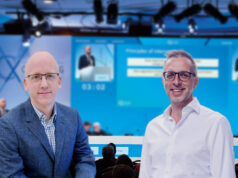Physician-Modified Endovascular Grafts are a safe and effective alternative for patients with juxtarenal aneurysms, who are unsuitable for open surgical repair, says Benjamin W Starnes, University of Washington, Seattle, USA. Starnes tells Vascular News how he modifies the grafts immediately before the procedure and how this can reduce time and costs.
Fenestrated stent grafts with reinforced fenestrations permit the incorporation of the visceral and renal arteries into endovascular repair enabling an adequate proximal sealing zone. These devices require a six to eight-week period for customisation and are not currently commercially available in the United States.
Data from a study using physician-modified endografts were presented by Starnes at the Society for Vascular Surgery Annual Meeting in Chicago. The study is a prospective, consecutively enrolling, non-randomised single institution evaluation of the safety and efficacy of physician modification of a currently FDA-approved device (Zenith Flex, Cook Medical) to preserve branch vessels when used in the treatment of patients with elective, symptomatic or ruptured juxtarenal aortic aneurysms.
Forty seven consecutive patients underwent fenestrated endovascular repair using a physician-modified endovascular graft from 2007 to 2010. Thirty eight patients (81%) were symptomatic or had rapid aneurysm expansion. Forty patients (85%) were ASA (American Society of Anesthesiologists) category III or IV.
Eighty two fenestrations were created for 58 renal arteries, 16 superior mesenteric arteries, three coeliac arteries and three accessory renal vessels. Mean follow-up was 607 days (range 425–1,460). Mean operative time was 185 minutes, mean contrast usage was 98cc and mean fluoroscopy time was 48 minutes. There were six complications (12.7%) – three (6.4%) were access-related and three (6.4%) were procedure-related and included one stroke, one renal failure and one branch artery dissection. On follow-up, only six patients (12.8%) had an endoleak (one type I and five type II). Operative mortality was 0%. In-hospital and 30-day mortality was 2% with one patient expiring due to aspiration on the ward after successful endovascular repair. Two patients died during follow-up; one at 58 days due to cessation of dialysis and one at 485 days due to stent graft migration and occlusion of the superior mesenteric artery. There were two deaths in the first year, one in the second and zero in the most recent year of experience. One patient with endoleak had aneurysm sac expansion at one year requiring secondary intervention.
“Longer-term follow-up is needed to assess the durability of repair and potential for device-related complications,” Starnes said.
In January 2011, the FDA approved an investigator-initiated investigational device exemption study to be conducted by Starnes. The single-centre study will have an anticipated enrolment of 150 patients. This is currently the only approved physician-modified endovascular graft study in the United States, the Society for Vascular Surgery noted.
Benjamin Starnes spoke to Vascular News about his experience with physician-modified endovascular grafts.
What are the benefits of a physician-modified endovascular graft for juxtarenal aneurysms? Are there any disadvantages?
It gives up the ability to apply endovascular techniques to a broader range of patients who would have no other alternatives and would face death due to aneurysm rupture. The other benefits are the ability to modify the graft immediately and avoid the 6–8 week time for a customised graft. This is especially important in patients presenting with rupture or a symptomatic aneurysm where time is of the essence. The disadvantage is the unknown long-term durability.
When and how did you learn how to make the fenestrations yourself?
We did our first case in April 2007 and began with single fenestrations for a discrepant renal artery. We then moved higher and higher. I learned by tinkering with expired devices and talking with experts from all over the world who also had some experience and were learning at the time.
How do you create the fenestrations and what kind of tools are used?
Calipers, precise measuring instruments, hand-held bovies and most importantly, a thorough understanding of the device. This is not a technique for a provider who does a low to moderate volume of EVAR (
In terms of costs, is it cheaper when you customise the device?
Absolutely! The cost is essentially the cost of the device plus a few stents.
Can you explain how your IDE study will work? What are the results obtained so far?
We began our investigational device exemption study (IDE) in April 2011 and have enrolled 16 patients to date. We hope to provide an interim analysis of the results to date when we file our Annual Report with the FDA in December 2011.













